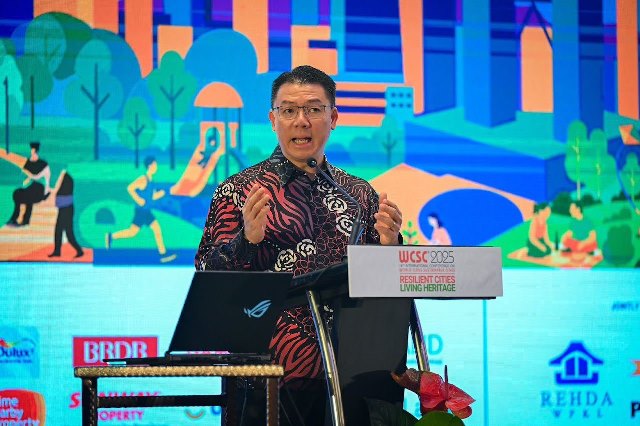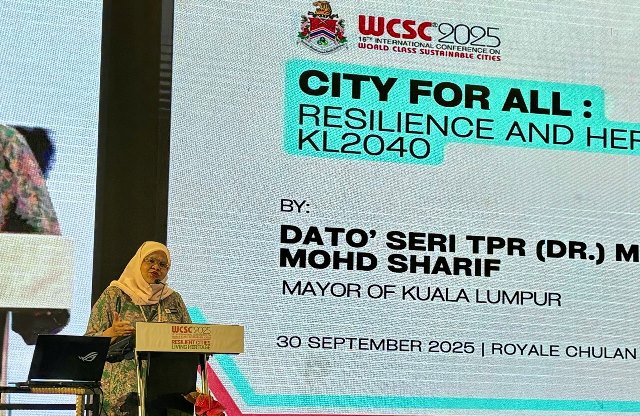
- The landmarks include Seri Negara, the National Textiles Museum, the Sultan Abdul Samad Building, and the old General Post Office in KL.
KUALA LUMPUR (Sept 30): Malaysia will restore seven national landmarks in the capital city, with RM700 million allocated to give the heritage sites a new lease of life.
The landmarks include Seri Negara, the National Textiles Museum, the Sultan Abdul Samad Building, and the old General Post Office in KL, said Housing and Local Government Minister Nga Kor Ming at the 16th International Conference on World Class Sustainable Cities (WCSC) 2025 held here today.
“These seven iconic landmarks will soon be revitalised to showcase Malaysia’s heritage and culture.
“This is part of our effort to elevate ‘Made by Malaysia’ brands, with the hope that one day they can grow into international names, standing alongside Starbucks and other global players,” he said.
Read also
WCSC 2025 to tackle urban identity, climate and smart tech
WCSC 2025: Culture key to thriving cities, not just socially, but economically
WCSC 2025: Plant trees, save cities
WCSC 2025: Technology, data playing greater roles in shaping cities
Regarding the upcoming Urban Renewal Bill, Nga said the ministry is open to constructive views and suggestions to refine it.
He said the Bill is intended to provide an orderly and sustainable approach to redevelopment while ensuring the rights and interests of original landowners are protected.
“The Urban Renewal Bill is aligned with the central theme of the WCSC, that sustainable development must be supported by a comprehensive legal framework.
“It will form the basis for systematic renewal efforts while safeguarding owners’ rights,” he told the press after the opening ceremony.
He added that the ministry remains receptive to thoughtful proposals but will reject attempts by any party to politicise the matter.
“We welcome constructive input for the benefit of the people. But if there are those who try to exploit the issue for narrow political gain, we reject that. What we want is politics that builds, not politics that destroys,” he said.
The Bill was first read in Parliament earlier this year and was supposed to be read a second time, but that has been postponed to the next sitting. It is meant to redevelop old and run-down housing areas in a more planned, fair and inclusive way.
DBKL will cut energy and water use at its own facilities
KL Mayor Datuk Seri Maimunah Mohd Sharif said the city is committed to achieving net zero by 2050 under the KL Climate Action Plan, with an interim goal of reducing greenhouse gas emissions by 70% compared to 2010 levels.
As part of that effort, KL City Hall (DBKL) will cut energy and water use at its own facilities by 25% by 2030 through LED lights, smart controls and solar power.
“Our aim is to start at home so we can set the standard for the rest of the city,” she said.

Maimunah added that the city’s development blueprint, the KL Local Plan (PTKL2040), targets 305,000 affordable homes by 2040, nearly 40% of KL’s housing stock, and has identified 139 urban renewal sites, starting with ageing public flats.
On transport, she said the goal is for 70% of trips to be made by public transit by 2040, supported by expanded rail, buses, cycling lanes and 254km of green-blue connectors linking parks, rivers and communities.
“A city without activities is a city without soul. Infrastructure is essential, but so are the festivals, performances, markets and rituals that give life to our streets. They are not side events, they are the heartbeat of urban life,” she said.
Improve pavements, street lighting, shades to enhance cities
Meanwhile, Hong Kong-based architects, urbanists and designers firm Oval Partnership project director Justin Lau said a city has a natural instinct that guides people through its spaces.
He said that could be something as simple as improving pavement quality, enhancing street lighting, or adding tree-lined streets.
“These might seem like small steps, but they create environments where people feel safe and comfortable and when that happens, people naturally come.
“This is what we often advise stakeholders and advocates of human spaces: Do something meaningful with public space, and it will activate itself,” he said during the keynote dialogue session.

Tech can’t replace face-to-face connection
Oval Partnership project director and head of digital placemaking Philip Clarke added that more neighbourhoods and precincts are now building online platforms where communities can share concerns, celebrate their neighbourhoods and connect.
“These platforms allow people to convene physically and digitally, creating memories they can revisit and sustain over time.
“But human physical presence is still vital,” he said during the same session.
Clarke stressed that technology alone cannot create the same sense of connection as face-to-face encounters.
Especially in living heritage cities, he said, it is essential to create spaces where people can share stories, experiences and culture.
“That’s what good narrative placemaking is about—slowing down, savouring what’s meaningful, and carrying those stories forward,” he said.
WCSC 2025, themed “Resilient Cities, Living Heritage”, is organised by the Malaysian Institute of Planners (MIP), Real Estate and Housing Developers’ Association (Rehda) Malaysia and the Malaysian Institute of Architects (PAM), in collaboration with DBKL and EdgeProp as media partner.
The conference focuses on three areas: culture as a catalyst in revitalising urban identity, climate adaptation and nature-based solutions, and smart technologies for inclusive urban futures.
As Penang girds itself towards the last lap of its Penang2030 vision, check out how the residential segment is keeping pace in EdgeProp’s special report: PENANG Investing Towards 2030.

.jpg?7__BKHlB_7DynBGupWbdOMF.F7TnnrKU)



